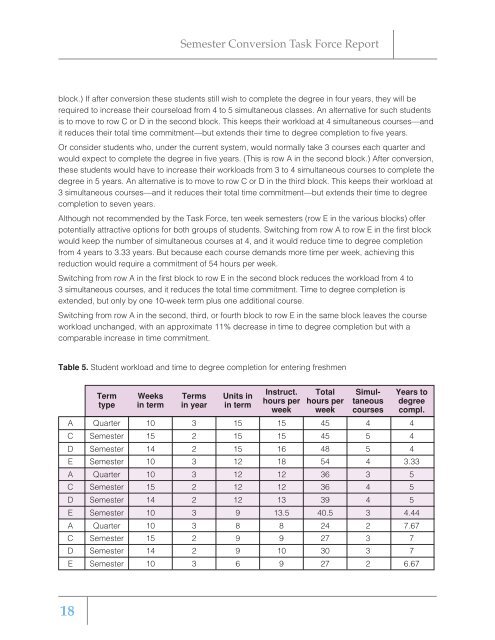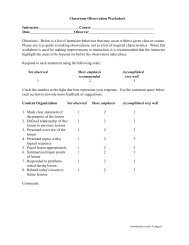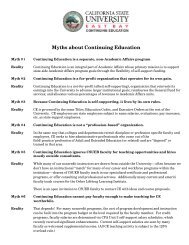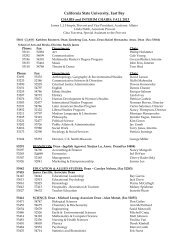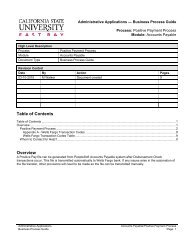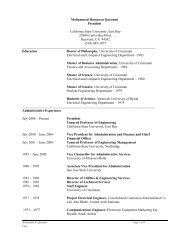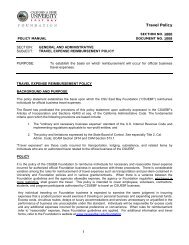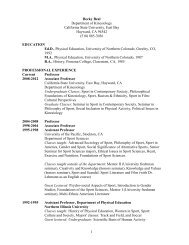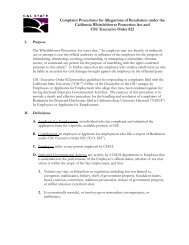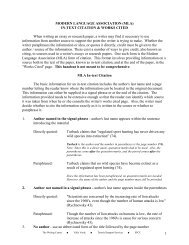Report of the Semester Conversion Task Force - California State ...
Report of the Semester Conversion Task Force - California State ...
Report of the Semester Conversion Task Force - California State ...
- No tags were found...
Create successful ePaper yourself
Turn your PDF publications into a flip-book with our unique Google optimized e-Paper software.
<strong>Semester</strong> <strong>Conversion</strong> <strong>Task</strong> <strong>Force</strong> <strong>Report</strong>block.) If after conversion <strong>the</strong>se students still wish to complete <strong>the</strong> degree in four years, <strong>the</strong>y will berequired to increase <strong>the</strong>ir courseload from 4 to 5 simultaneous classes. An alternative for such studentsis to move to row C or D in <strong>the</strong> second block. This keeps <strong>the</strong>ir workload at 4 simultaneous courses—andit reduces <strong>the</strong>ir total time commitment—but extends <strong>the</strong>ir time to degree completion to five years.Or consider students who, under <strong>the</strong> current system, would normally take 3 courses each quarter andwould expect to complete <strong>the</strong> degree in five years. (This is row A in <strong>the</strong> second block.) After conversion,<strong>the</strong>se students would have to increase <strong>the</strong>ir workloads from 3 to 4 simultaneous courses to complete <strong>the</strong>degree in 5 years. An alternative is to move to row C or D in <strong>the</strong> third block. This keeps <strong>the</strong>ir workload at3 simultaneous courses—and it reduces <strong>the</strong>ir total time commitment—but extends <strong>the</strong>ir time to degreecompletion to seven years.Although not recommended by <strong>the</strong> <strong>Task</strong> <strong>Force</strong>, ten week semesters (row E in <strong>the</strong> various blocks) <strong>of</strong>ferpotentially attractive options for both groups <strong>of</strong> students. Switching from row A to row E in <strong>the</strong> first blockwould keep <strong>the</strong> number <strong>of</strong> simultaneous courses at 4, and it would reduce time to degree completionfrom 4 years to 3.33 years. But because each course demands more time per week, achieving thisreduction would require a commitment <strong>of</strong> 54 hours per week.Switching from row A in <strong>the</strong> first block to row E in <strong>the</strong> second block reduces <strong>the</strong> workload from 4 to3 simultaneous courses, and it reduces <strong>the</strong> total time commitment. Time to degree completion isextended, but only by one 10-week term plus one additional course.Switching from row A in <strong>the</strong> second, third, or fourth block to row E in <strong>the</strong> same block leaves <strong>the</strong> courseworkload unchanged, with an approximate 11% decrease in time to degree completion but with acomparable increase in time commitment.Table 5. Student workload and time to degree completion for entering freshmenTerm Weeks Terms Units intype in term in year in termInstruct. Total Simul- Years tohours per hours per taneous degreeweek week courses compl.A Quarter 10 3 15 15 45 4 4C <strong>Semester</strong> 15 2 15 15 45 5 4D <strong>Semester</strong> 14 2 15 16 48 5 4E <strong>Semester</strong> 10 3 12 18 54 4 3.33A Quarter 10 3 12 12 36 3 5C <strong>Semester</strong> 15 2 12 12 36 4 5D <strong>Semester</strong> 14 2 12 13 39 4 5E <strong>Semester</strong> 10 3 9 13.5 40.5 3 4.44A Quarter 10 3 8 8 24 2 7.67C <strong>Semester</strong> 15 2 9 9 27 3 7D <strong>Semester</strong> 14 2 9 10 30 3 7E <strong>Semester</strong> 10 3 6 9 27 2 6.6718


